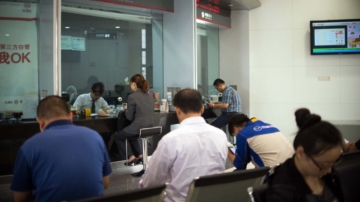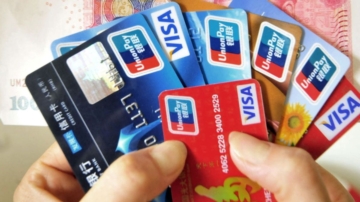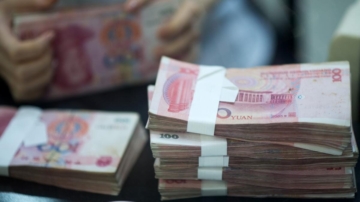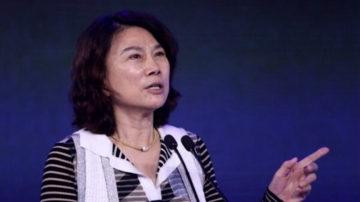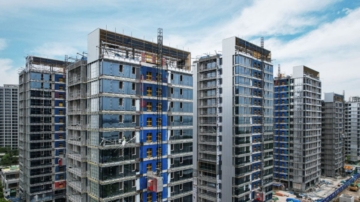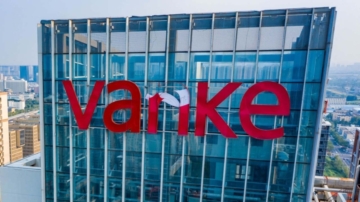【新唐人2014年10月01日訊】今年上半年,中國十大上市銀行的不良貸款率創下近四年來新高,目前正在以兩到三折,甚至更低的價格,出售給資產管理公司。作為買賣銀行壞賬主力軍的四大資管公司,上半年利潤增長高達30%以上,不過欠央行的再貸款卻沒有償還。那麼這四大資管公司賺的錢去了哪裡?這些壞賬最後又由誰買單?請看報導。
普華永道發佈的最新數據顯示,中國十大銀行上半年的不良貸款餘額和不良貸款率,「雙雙上升」。上半年不良貸款餘額接近去年全年增幅,不良貸款率超過1%,銀行壞賬創下近四年新高。
另外,據銀監會的數據,今年上半年,中國銀行業金融機構不良貸款餘額達6944億,較去年末上升1023億元,已經超過去年全年不良貸款的增加規模。
目前,銀行正在大比例核銷壞賬,以兩到三折,甚至一折或更低的價格,向資管公司出售資產包。據《人民網》報導,中信銀行深圳分行在上海聯合產權交易所掛牌一個資產包,含476筆不良債權、未償本金餘額16.69億元的資產包,掛牌價只有2000萬元,中間差額幾十倍。
華融資產、東方資產、長城資產和信達資產,這四大資產管理公司是買賣銀行壞賬的主力軍。1999年,中共決定將四大國有銀行1.4萬億元的巨款壞賬剝離,對口設立了這四大資管公司。
財政部作為唯一股東向每家公司注資100億元,並擔保四大資管公司從央行獲得6041億元再貸款;資管公司再向四大國有銀行及國家開發銀行發行8110億元金融債券,以此按1:1的對價購買不良資產。也就是說,當時,這四大資管公司拿到1.4萬億不良資產時,不但沒有付出一分錢,每家公司還從財政部拿到了100億元。
中國金融智庫研究員鞏勝利:「國有的資產廉價給賣了,這當中的貓膩,它的結果,它懸殊的根源所在是很明白的一個問題,財政部或中央銀行再沒有很好的監管機制,這樣賣下去我覺得可能比較嚇人,長此以往虧的是國家,賺的肯定是資產管理公司。」
大陸《證券日報》評論說,今年上半年5581億元上市銀行不良貸款餘額壓力的背後,是資管公司的大豐收,它們賺得「盆滿缽滿」。
公開資料顯示,四大資管公司今年上半年的利潤增速都超過30%。其中長城資產達45%,東方資產達39%,華融資產達34.57%。而作為四大資管公司中唯一上市的信達資產,上半年收購853億元不良債權資產,比去年同期上升100.2%。其中傳統類不良資產增長率達240.0%,上半年淨利潤同比增長30.3%。
雖然這些資管公司靠超低價格吸收不良資產大發橫財,大陸《和訊》財經網專欄作家周彥武卻指出,四大資管公司目前仍然欠央行約1萬億,欠四大國有銀行8200億,原購入的1.4萬億不良資產也只有20%現金回收。
周彥武認為,無論這些欠款進入「共管賬戶」,還是債券延期、停息掛賬,都不過是在國家資產負債表的不同科目下「左兜換右兜」。
債務就是債務,企業核銷可以靠利潤,而財政核銷要靠納稅,央行核銷只能靠印錢,那麼銀行壞賬的最後由誰買單?
據披露,這些資產管理公司大多由中共太子黨經營。2011年,前中共黨魁江澤民孫子經營的博裕資本,投資5,000萬美元入股信達資產。2005年初,中共審計署披露,四家資產管理公司,被查出各類違規和管理不規範問題資金700多億元,發現案件線索38件、涉案資金67億元。
採訪編輯/劉惠 後製/陳建銘
China Bargained Away Bad Loans to Its
Asset Management Companies.
In the first half of 2014, China's ten major listed banks saw
a record high rate in non-performing loan ratios.
They are selling those loans at 20 to 30 percent of the
original prices, or even lower, to asset management firms.
As a result, China's four asset management firms reported
that their half-year profit has grown by over 30 percent.
However, they have not paid back loans from the
Central Bank. So, where do their profits go?
Who will finally pay the bill for those bad loans?
Let's look at the report below.
According to the latest statistics by PWC, China's ten major
banks had an increase in both total balance and ratios of
non-performing loans in the first half of 2014.
The total balance of non-performing loans has almost
reached the figure from the whole of 2013.
The ratio of non-performing loans also exceeds 1 percent,
a record high in the past 4 years.
The Banking Regulatory Commission also announced that,
China's financial industry had a total balance of 694.4 billion
Yuan ($113 B) in bad loans by the first half of 2014.
The figure increased by 102.3 billion Yuan ($16.7 B)
compared to the end of 2013.
The increment itself has exceeded that from the
whole of 2013.
China's banks are making big moves to eliminate bad loans.
They packaged those loans and are selling them to asset
management firms at hugely reduced prices.
People's Daily website reported that China Citic Bank's
Shenzhen branch is selling an asset package at Shanghai
United Assets and Equity Exchange (SUAEE).
The package includes creditor rights of 476 bad loans,
which total 1.67 billion Yuan ($270 M) of unpaid capital.
The package is sold at only 20 million Yuan ($3.3 M),
almost one eightieth of its original value.
Huarong, Orient, Great Wall and Cinda are the four asset
management companies that take most bad loans in China.
Back in 1999, the Chinese Communist Party (CCP) decided to
eliminate 1.4 trillion Yuan ($228 B) of bad loans from its
big four state-owned banks, and so established these
four asset management firms.
As the only shareholder, the CCP's Ministry of Finance
invested 10 billion Yuan ($1.63 B) into each company,
and offered warrants for them to obtain refinance of
604.1 billion Yuan ($98 B) from the Central Banks.
Then the four companies sold financial bonds of 811 billion
Yuan ($132 B) to the big four state-owned banks and the
China Development Bank. Bad assets were handed over to
those four companies with these two trades.
It is clear that the asset management firms did not spend
a single cent in“purchasing” the huge amount of bad loans.
In total they came to 1.4 trillion Yuan.
In addition, each company was given 10 billion Yuan
by the Ministry of Finance.
Gong Shengli,“dirty tricks of bargaining away state-owned
assets and the consequences are clearly big problems.
Neither the CCP's Ministry of Finance nor the Central Bank
has good supervision systems.
The result can be horrifying if things continue.
From a long-term point of view, the state will lose a lot
while asset management firms will make huge profits.”
China's Securities Daily said, listed banks were pressured
by bad loans totaling 558.1 billion Yuan.
However asset managers have made huge profits from that.
Open data shows all four asset management firms saw
more than 30 percent increase in profit.
The figures are: Great Wall 45 percent; Orient 39 percent;
Huarong 34.57 percent.
As the only listed company among the four, Cinda“purchased”
bad loans of 85.3 billion Yuan ($13.9 B) in the first half of 2014.
This was an increase of 100.2 percent from last year.
The rate of increase for traditional bad assets is 240 percent.
Cinda makes 30.3 percent more profit compared to
the same period of 2013.
Cinda and others are making huge profit by getting bargains.
However, Zhou Yanwu, a column writer of Hexun Finance,
commented that those four companies still owed about
1 trillion Yuan ($160 B) to the Central bank, and 820 billion
Yuan ($133.6 B) to the big four state-owned banks.
In addition, they have only retrieved 20 percent of
the 1.4-trillion-Yuan package in cash.
Zhou Yanwu said, trading bad loans, extending bonds,
suspending debts and other tricks are nothing more
than“moving state debts from one pocket to another”.
To clear debts, companies need profits and financial
departments need taxes.
The Central Bank has to print money. So in the end, who will
pay the bill for those bad loans in the banks?
Sources said, asset management companies are mostly
controlled by the CCP princelings.
In 2011, Boyu Capital which is run by Jiang Zemin's
grandson, invested 50 million dollars in Cinda.
In early 2005, the CCP's auditing administration revealed
that the four asset management firms were illegally using
or managing capitals totaling over 70 billion Yuan ($11.4 B).
Thirty-eight case clues were also found, which involved
a total of 6.7 billion Yuan ($1.1 B) in capital use.
Interview & edit/LiuHui Post-Production/Chen Jianming
普華永道發佈的最新數據顯示,中國十大銀行上半年的不良貸款餘額和不良貸款率,「雙雙上升」。上半年不良貸款餘額接近去年全年增幅,不良貸款率超過1%,銀行壞賬創下近四年新高。
另外,據銀監會的數據,今年上半年,中國銀行業金融機構不良貸款餘額達6944億,較去年末上升1023億元,已經超過去年全年不良貸款的增加規模。
目前,銀行正在大比例核銷壞賬,以兩到三折,甚至一折或更低的價格,向資管公司出售資產包。據《人民網》報導,中信銀行深圳分行在上海聯合產權交易所掛牌一個資產包,含476筆不良債權、未償本金餘額16.69億元的資產包,掛牌價只有2000萬元,中間差額幾十倍。
華融資產、東方資產、長城資產和信達資產,這四大資產管理公司是買賣銀行壞賬的主力軍。1999年,中共決定將四大國有銀行1.4萬億元的巨款壞賬剝離,對口設立了這四大資管公司。
財政部作為唯一股東向每家公司注資100億元,並擔保四大資管公司從央行獲得6041億元再貸款;資管公司再向四大國有銀行及國家開發銀行發行8110億元金融債券,以此按1:1的對價購買不良資產。也就是說,當時,這四大資管公司拿到1.4萬億不良資產時,不但沒有付出一分錢,每家公司還從財政部拿到了100億元。
中國金融智庫研究員鞏勝利:「國有的資產廉價給賣了,這當中的貓膩,它的結果,它懸殊的根源所在是很明白的一個問題,財政部或中央銀行再沒有很好的監管機制,這樣賣下去我覺得可能比較嚇人,長此以往虧的是國家,賺的肯定是資產管理公司。」
大陸《證券日報》評論說,今年上半年5581億元上市銀行不良貸款餘額壓力的背後,是資管公司的大豐收,它們賺得「盆滿缽滿」。
公開資料顯示,四大資管公司今年上半年的利潤增速都超過30%。其中長城資產達45%,東方資產達39%,華融資產達34.57%。而作為四大資管公司中唯一上市的信達資產,上半年收購853億元不良債權資產,比去年同期上升100.2%。其中傳統類不良資產增長率達240.0%,上半年淨利潤同比增長30.3%。
雖然這些資管公司靠超低價格吸收不良資產大發橫財,大陸《和訊》財經網專欄作家周彥武卻指出,四大資管公司目前仍然欠央行約1萬億,欠四大國有銀行8200億,原購入的1.4萬億不良資產也只有20%現金回收。
周彥武認為,無論這些欠款進入「共管賬戶」,還是債券延期、停息掛賬,都不過是在國家資產負債表的不同科目下「左兜換右兜」。
債務就是債務,企業核銷可以靠利潤,而財政核銷要靠納稅,央行核銷只能靠印錢,那麼銀行壞賬的最後由誰買單?
據披露,這些資產管理公司大多由中共太子黨經營。2011年,前中共黨魁江澤民孫子經營的博裕資本,投資5,000萬美元入股信達資產。2005年初,中共審計署披露,四家資產管理公司,被查出各類違規和管理不規範問題資金700多億元,發現案件線索38件、涉案資金67億元。
採訪編輯/劉惠 後製/陳建銘
China Bargained Away Bad Loans to Its
Asset Management Companies.
In the first half of 2014, China's ten major listed banks saw
a record high rate in non-performing loan ratios.
They are selling those loans at 20 to 30 percent of the
original prices, or even lower, to asset management firms.
As a result, China's four asset management firms reported
that their half-year profit has grown by over 30 percent.
However, they have not paid back loans from the
Central Bank. So, where do their profits go?
Who will finally pay the bill for those bad loans?
Let's look at the report below.
According to the latest statistics by PWC, China's ten major
banks had an increase in both total balance and ratios of
non-performing loans in the first half of 2014.
The total balance of non-performing loans has almost
reached the figure from the whole of 2013.
The ratio of non-performing loans also exceeds 1 percent,
a record high in the past 4 years.
The Banking Regulatory Commission also announced that,
China's financial industry had a total balance of 694.4 billion
Yuan ($113 B) in bad loans by the first half of 2014.
The figure increased by 102.3 billion Yuan ($16.7 B)
compared to the end of 2013.
The increment itself has exceeded that from the
whole of 2013.
China's banks are making big moves to eliminate bad loans.
They packaged those loans and are selling them to asset
management firms at hugely reduced prices.
People's Daily website reported that China Citic Bank's
Shenzhen branch is selling an asset package at Shanghai
United Assets and Equity Exchange (SUAEE).
The package includes creditor rights of 476 bad loans,
which total 1.67 billion Yuan ($270 M) of unpaid capital.
The package is sold at only 20 million Yuan ($3.3 M),
almost one eightieth of its original value.
Huarong, Orient, Great Wall and Cinda are the four asset
management companies that take most bad loans in China.
Back in 1999, the Chinese Communist Party (CCP) decided to
eliminate 1.4 trillion Yuan ($228 B) of bad loans from its
big four state-owned banks, and so established these
four asset management firms.
As the only shareholder, the CCP's Ministry of Finance
invested 10 billion Yuan ($1.63 B) into each company,
and offered warrants for them to obtain refinance of
604.1 billion Yuan ($98 B) from the Central Banks.
Then the four companies sold financial bonds of 811 billion
Yuan ($132 B) to the big four state-owned banks and the
China Development Bank. Bad assets were handed over to
those four companies with these two trades.
It is clear that the asset management firms did not spend
a single cent in“purchasing” the huge amount of bad loans.
In total they came to 1.4 trillion Yuan.
In addition, each company was given 10 billion Yuan
by the Ministry of Finance.
Gong Shengli,“dirty tricks of bargaining away state-owned
assets and the consequences are clearly big problems.
Neither the CCP's Ministry of Finance nor the Central Bank
has good supervision systems.
The result can be horrifying if things continue.
From a long-term point of view, the state will lose a lot
while asset management firms will make huge profits.”
China's Securities Daily said, listed banks were pressured
by bad loans totaling 558.1 billion Yuan.
However asset managers have made huge profits from that.
Open data shows all four asset management firms saw
more than 30 percent increase in profit.
The figures are: Great Wall 45 percent; Orient 39 percent;
Huarong 34.57 percent.
As the only listed company among the four, Cinda“purchased”
bad loans of 85.3 billion Yuan ($13.9 B) in the first half of 2014.
This was an increase of 100.2 percent from last year.
The rate of increase for traditional bad assets is 240 percent.
Cinda makes 30.3 percent more profit compared to
the same period of 2013.
Cinda and others are making huge profit by getting bargains.
However, Zhou Yanwu, a column writer of Hexun Finance,
commented that those four companies still owed about
1 trillion Yuan ($160 B) to the Central bank, and 820 billion
Yuan ($133.6 B) to the big four state-owned banks.
In addition, they have only retrieved 20 percent of
the 1.4-trillion-Yuan package in cash.
Zhou Yanwu said, trading bad loans, extending bonds,
suspending debts and other tricks are nothing more
than“moving state debts from one pocket to another”.
To clear debts, companies need profits and financial
departments need taxes.
The Central Bank has to print money. So in the end, who will
pay the bill for those bad loans in the banks?
Sources said, asset management companies are mostly
controlled by the CCP princelings.
In 2011, Boyu Capital which is run by Jiang Zemin's
grandson, invested 50 million dollars in Cinda.
In early 2005, the CCP's auditing administration revealed
that the four asset management firms were illegally using
or managing capitals totaling over 70 billion Yuan ($11.4 B).
Thirty-eight case clues were also found, which involved
a total of 6.7 billion Yuan ($1.1 B) in capital use.
Interview & edit/LiuHui Post-Production/Chen Jianming

